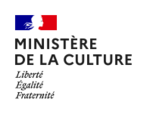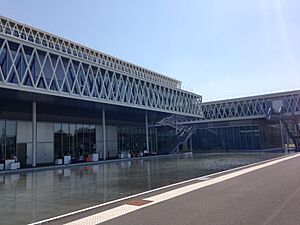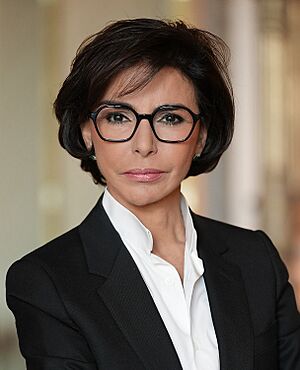Ministry of Culture (France) facts for kids
Quick facts for kids Minister of Culture |
|
|---|---|
 |
|
| Member of | Council of Ministers |
| Reports to | President of the Republic and to Parliament |
| Residence | Palais-Royal |
| Seat | Paris, France |
| Appointer | President of the Republic |
| Term length | No fixed term
Remains in office while commanding the confidence of the National Assembly and the President of the Republic
|
| Constituting instrument | Constitution of 4 October 1958 |
| Formation | 8 January 1959 |
| First holder | André Malraux |
| Salary | €9,940 per month |
The Ministry of Culture (called Ministère de la Culture in French) is a special part of the Government of France. Its main job is to look after France's culture and arts. This includes things like national museums and important historical buildings, known as monuments historiques.
The Ministry helps keep French identity strong. It does this by supporting and protecting many kinds of art. This includes visual arts, theater, music, dance, architecture, books, TV, and movies. They work to promote these arts both in France and around the world.
A big part of its budget goes to managing the National Archives. These are huge collections of historical documents. The Ministry also supports regional culture centers, called Maisons de la culture.
The main office of the Ministry is in the Palais-Royal in Paris. The person in charge is the Minister of Culture. The current Minister is Rachida Dati, who started on January 11, 2024.
Contents
History of the Ministry of Culture
The idea of the government supporting art is very old in France. It goes back to the 16th century, during the Renaissance. People believed that art was important for a country's reputation. Kings like Louis XIV had ministers who supported artists and created art schools.
Founding the Modern Ministry
The modern Ministry of Culture was officially created in 1959. This happened under President Charles de Gaulle. The very first Minister of Culture was a famous writer named André Malraux.
Malraux had an important goal: to make culture available to everyone. This idea, called the "right to culture," was even in France's Constitution. He wanted to help people across France experience art. He also aimed to show the "greatness" of France after World War II. To do this, he opened many regional cultural centers. He supported both traditional and modern art forms.

Culture for Everyone
Later, under President François Mitterrand, Jack Lang became the Minister of Culture. He was very open to popular culture. This included things like jazz, rock and roll, rap music, graffiti, bande dessinées (comic books), fashion, and even food.
Jack Lang famously said, "economy and culture: it's the same fight." This meant he believed that culture was important for the country's economy and its people. He helped create the Fête de la Musique, a big music festival. He also oversaw many huge building projects in Paris. These included the new Louvre pyramid, the Musée d'Orsay, and the Bibliothèque nationale (National Library).
Protecting the French Language
Another important Minister was Jacques Toubon. He introduced laws to protect the French language. For example, these laws made sure that advertisements with foreign words also included a French translation. They also required French radio stations to play a certain amount of French music. This was done to keep the French language strong.
How the Ministry of Culture Works
The Ministry of Culture has different teams that handle specific areas.
Main Departments
- National Monuments and Heritage: A team called the Direction de l'architecture et du patrimoine looks after historical buildings and sites. They keep detailed lists of these important places.
- National Archives: The Direction des archives de France manages the National Archives. These archives store millions of historical documents.
- Books and Reading: The Direction du livre et de la lecture supports French literature and the book industry.
- Music, Dance, and Theater: The Direction de la musique, de la danse, du théâtre et des spectacles helps promote and support music, dance, and theater.
- National Museums: The Direction des Musées de France is in charge of France's national museums.
Other Important Teams
The Ministry also works with other groups:
- Visual Arts: The Délégation aux arts plastiques supports painting, sculpture, and other visual arts.
- French Language: The Délégation générale à la langue française et aux langues de France works to protect and promote the French language and other languages spoken in France.
- Cinema: The Ministry helps manage the National Centre of Cinema. This group supports the French film industry.
On a local level, the Ministry has offices in different regions and departments. These local offices help manage cultural affairs and historical sites in their areas.
Cultural Activities and Programs
The Ministry of Culture is involved in many exciting cultural activities and programs each year:
- Fête de la Musique: This is a popular annual music festival held across France. On this day, musicians play for free in public spaces.
- Festival d'Avignon: This is one of the world's most famous theater festivals.
- Public Establishment of the Palace, Museum and National Estate of Versailles: The Ministry helps manage the famous Palace of Versailles.
- Joconde Database: This is an online database where you can find information about objects in French museums.
- Base Mérimée: This is another online database that lists thousands of historical monuments in France.
- Maître d'art program: This program helps pass on traditional crafts and skills from master artisans to new generations.


